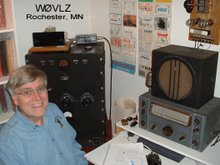
Last week I paid a visit to my friend Skip, K7YOO, in Winona. While rooting around in his parts storage I noticed a little transmitter. I've a weakness for QRP homebrew and this one, with miniature tubes, is of an era I don't have covered. A couple of days ago Skip dropped it off here in Rochester as he headed for the airport.
It is a version of the "QRP Midget" first described in July 1967 Popular Electronics by W5LET. Dave Ingram also covered it in November 1992 CQ. This one is build in a little bigger box with
 an added current meter and RF choke in the B+ line but otherwise it is a good copy of the original.
an added current meter and RF choke in the B+ line but otherwise it is a good copy of the original.This transmitter uses tubes designed for battery powered portable radios common just before transistors took over the market. Two "power" pentodes in parallel run about a watt out on 80 or 40...not a barn burner but it should be good for some contacts.
Now I need to come up with a receiver along the same lines...


















